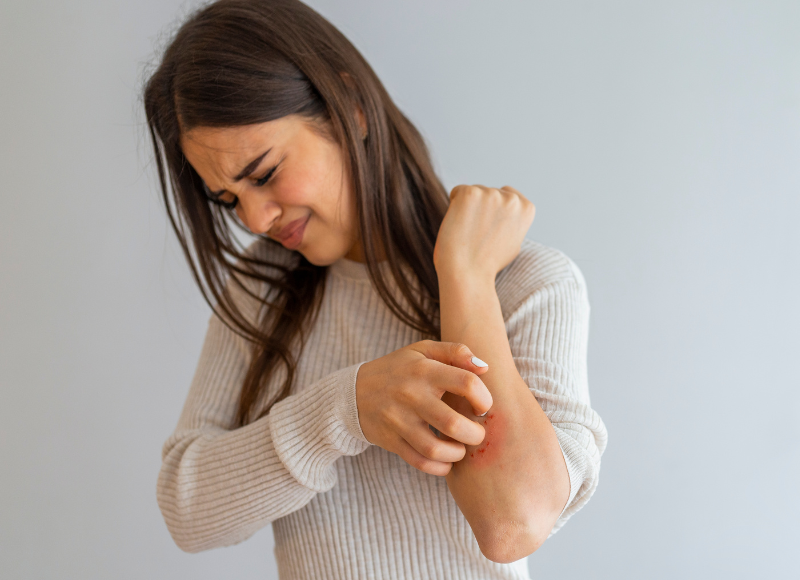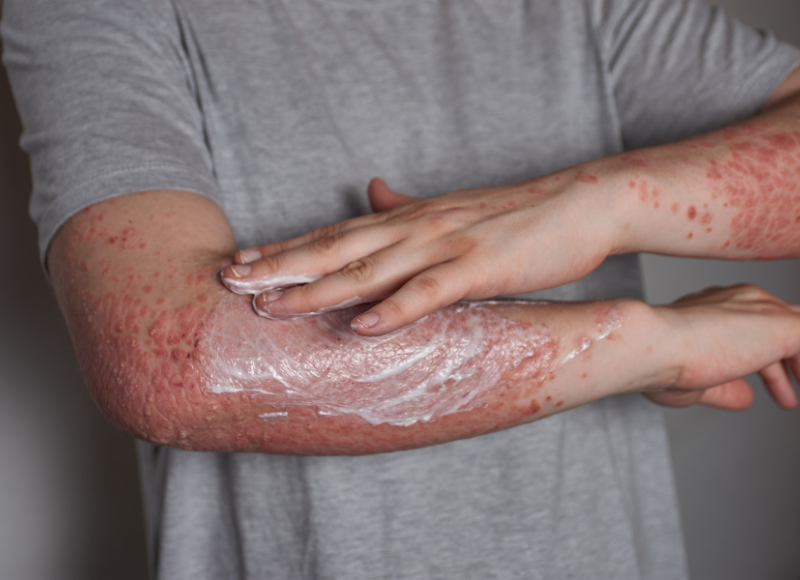
Psoriasis
Psoriasis is a chronic autoimmune condition that causes rapid skin cell turnover, leading to thick, red, scaly patches on the skin. Here’s a brief overview of its causes, types, and symptoms:
Causes
- Immune system dysfunction: The immune system mistakenly attacks healthy skin cells, causing inflammation and rapid skin cell production.
- Genetics: A family history of psoriasis increases the risk.
- Triggers: Stress, infections, skin injuries, certain medications, and environmental factors can trigger flare-ups.
Types Of Psoriasis
- Plaque psoriasis: The most common type, characterized by dry, raised, red skin lesions (plaques) with silvery scales, usually on elbows, knees, scalp, and lower back.
- Guttate psoriasis: Common in children and young adults, marked by small, drop-shaped lesions, often triggered by infections like strep throat.
- Inverse psoriasis: Causes smooth, red, inflamed skin patches in body folds, such as under the breasts or around the groin.
- Pustular psoriasis: A rare type, featuring white pustules surrounded by red skin, either localized or widespread.
- Erythrodermic psoriasis: The least common, involves a red, peeling rash over the entire body, with severe itching or pain—this is a medical emergency.


Symptoms
- Red, scaly patches of skin.
- Dry, cracked skin that may bleed.
- Itching, burning, or soreness
- Thickened or pitted nails
- Stiff, swollen joints (in cases with psoriatic arthritis)
Homoeopathic Medicines For Psoriasis
- Arsenicum: Bran-colored scales on head coming down on forehead: desquamation of the skin of the body. Small red pimples gradually increase and are covered with scarf-like fish-scales; skin dry cold and bluish, with violent burning.
- Arsenic iodatum: Marked exfoliation of skin in large scales, leaving a raw exuding surface beneath; skin dry, scaly, itching, with watery oozing: worse from washing.
- Calc. Carb: Skin of the body rough, dry, and as if covered with a kind of miliary eruptions, with burning, smarting and itching, forming scales.
- Clematis, Scaly tetters, discharging a sanious pus, with redness, heat and swelling of the skin, with insupportable itching in the heat of the bed and after washing; worse on the face, hands and scalp around oeciput; looks inflamed during increasing and dry during decreasing moon.
- Corallium Rubrum: Psoriasis of palms and soles in persons who have in them a combination of Syphilis and Psora. Red spots on palms, at first of coral color, then darker and finally coppery.
- Fluoric Acid: Rough and hard skin and eruption of little red blotches on the body with persistent itching in small spots here and there over the body, with desquamation of scales; itching worse from warmth, better from cold.
- Graphites: Obstinate dryness of the skin and absence of perspiration and scabious eruptions sometimes with secretion of corrosive serum or with itching in the evening and at night.
- Hydrocotyle: Dry eruptions and great thickening of the epidermoid of soles. Psoriasis Gyrata, on trunk and extremities, palms and soles.
- Kali Ars: Psoriasis in numerous patches with great itching, causing him to scratch till an ichorous fluid discharges, forming a hard cake; the patches scale off and are replaced by smaller ones and leave behind them a red skin.
- Kali Brom: Rose-colored eruptions on lower extremities; pustules in centre of patches become umbilicated, exuding a creamy moisture and forming thick, yellow scabs; Syphilitic Psoriasis.
These homeopathic medicines should be taken under the guidance of a qualified homeopathic practitioner.
